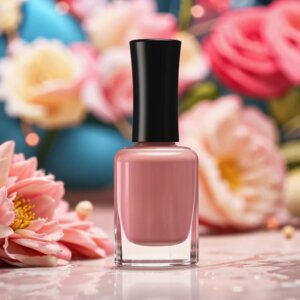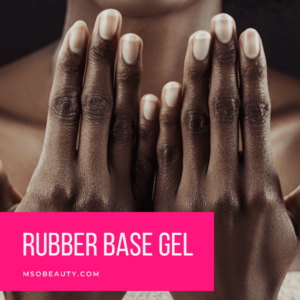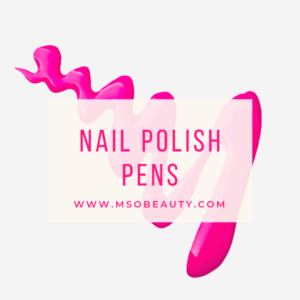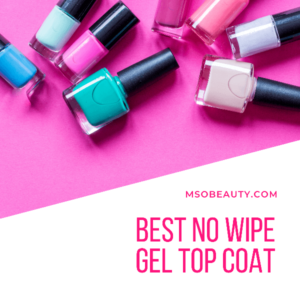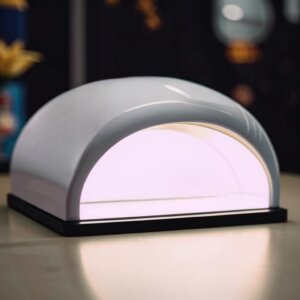CND Shellac is a very popular salon-grade gel nail polish. It’s quite easy to use and is quite durable.
CND promises that Shellac can stay on your nails for up to 14 days of you apply it right.
CND Shellac
Many people choose Shellac for their gel manicures and I’m sure they would like to know the CND Shellac ingredients list and what these ingredients actually mean.
Have you ever wondered whether it’s safe to use Shellac?
You can rest assured that Shellac is quite safe for your nails, according to CND.

Non-toxic
It’s a non-toxic gel nail polish.
According to its manufacturer, CND, Shellac is 7-free.
It means that it doesn’t contain any of the most harmful and toxic substances and thus it’s pretty gentle on the nails.
Therefore it’s free of toluene, camphor, formaldehyde, phthalates (DBP), formaldehyde resin, xylene, and methyl ethyl ketone (MEK).
There’s an explanation of what these substances are in my article about non-toxic gel nail polishes.
Vegan
Shellac is also vegan and cruelty-free.
It doesn’t contain any animal-derived ingredients and is not being tested on animals.
No lac bug secret
Shellac is just a pretty and catchy brand name that the company has chosen to market its products under.
Contrary to the popular belief, CND Shellac contains no real “shellac”, which is a lac bug secret, as you can see for yourself in the list of ingredients I’ve added below. None of these ingredients contains shellac in any form.
So this polish is indeed vegan.
More gentle on the nails
In addition to that, you don’t need to buff the shine off your nails before using Shellac. So it’s more gentle on your nail plate than some other gel nail polishes.
It’s no longer required to cure Shellac with a UV light.
Previously Shellac was a UV-only nail polish.
But recently CND has reformulated Shellac and you can now cure it with an LED lamp.
Shellac is also easy to soak off. It’s not necessary to file it off with a nail drill.
Here is a list of CND Shellac ingredients (according to CND) and their most important qualities:
CND Shellac ingredients
- Butyl Acetate
- Bis-HEMA Poly(1,4-Butanediol)-22/IPDI Copolymer
- Cellulose Acetate Butyrate
- PPG-5 Methacrylate
- Tetrahydrofurfuryl Methacrylate
- Di-HEMA Trimethylhexyl Dicarbamate
- Silica
- Hydroxypropyl Methacrylate
- Phenyldimethoxyacetophenone.
Butyl Acetate
Butyl acetate is a colorless liquid that smells like apples or sometimes like bananas.
It’s a common ingredient in nail polishes, nail polish removers, and other nail products, such as base coats.
It functions as a solvent for other nail polish ingredients.
Butyl acetate is actually found in nature. It lends flavor to fruits, especially red apples.
That’s why it smells like apples. Or to be precise, apples smell like butyl acetate.
So it’s also used as an apple flavoring in cosmetics and in the food industry, in candy, and other sweets.
And it also plays part in Shellac’s and other nail polishes’ odor.
Cellulose Acetate Butyrate
Cellulose acetate butyrate is used as a film-forming agent in nail polishes and gel nail polishes, especially in top coats.
This chemical forms a continuous film coating on the nail plate.
It’s clear and doesn’t yellow. So your white Shellac polish won’t turn into a yellow one.
Cellulose acetate butyrate can also be found in non-acetone nail polish removers.
The leading manufacturer of this chemical is Eastman. It was originally used in automotive coatings and photographic films (remember Eastman Kodak?).
According to the Environmental Working Group (EWG) database, cellulose acetate butyrate is non-toxic and non-allergenic.
Silica
Silica is a silicon oxide that is used as a thickening agent in nail polishes.
This chemical evenly distributes pigments in polishes.
The kind of silica, amorphous silica, used in cosmetics and nail polishes is not dangerous.
Only crystalline silica is actually hazardous when used in cosmetics, but it’s a different type of silica, not used in Shellac.
Crystalline silica is also known as quartz and is often found in nature, in stone, granite, and clay. Sand is actually mostly made of quartz.
Silica gel, the stuff in those little “Do not eat” desiccant packets that you often find in bags and shoe boxes, is another form of silicon oxide. It’s necessary for absorbing moisture from bags, shoes, and other products to prevent mold from growing on them.
Phenyldimethoxyacetophenone
In addition to having the longest and the least pronounceable name on this list, phenyldimethoxyacetophenone is one of the most important ingredients of gel nail polishes.
It’s the chemical that causes gel nail polish to cure under UV/LED light.
Phenyldimethoxyacetophenone can polymerize acrylates under the influence of light and that makes Shellac harden in the lamp.
It’s not on the list of the most toxic chemicals and is safe in those concentrations that a bottle of Shellac contains.
Bis-HEMA Poly(1,4-Butanediol)-22/
IPDI Copolymer
This chemical with another lengthy name is a special polymer developed for gel nail polishes as a binding agent and is only mentioned in gel nail polish-related patents.
It’s not known to be hazardous or toxic, according to the Environmental Working Group (EWG) database.
PPG-5
Methacrylate, Tetrahydrofurfuryl Methacrylate, Hydroxypropyl
Methacrylate, Di-HEMA
Trimethylhexyl Dicarbamate
PPG-5 methacrylate, tetrahydrofurfuryl methacrylate, hydroxypropyl methacrylate, and Di-HEMA trimethylhexyl dicarbamate, are methacrylates that are commonly used in nail products.
Dentists use some methacrylates for restoring teeth.
They are actually the most important basic indgredient of all gel nail products, acrylics, gels, and polygels.
Methacrylates are used as bonding agents in the nail industry in acrylic, gel nail products, and in gel nail polishes. They polymerize and stay on your nails.
Unfortunately, some people can have an allergy to acrylates, according to the National Library of Medicine.
So there are those who are allergic to gel nail polishes.
While Shellac is one of the least allergenic gel nail polishes, and many people who are allergic to other gel nail polish brands use it without consequences, it still can cause allergy in those who have an intolerance to methylacrylates because, as a gel nail product, it’s based on them.
The good news is that this allergy is not very common and Shellac is safe for most users.
However, please consult your doctor about your allergies if you are unsure.
Vinylux As An Alternative
Thankfully, CND also manufactures Vinylux.
Vinylux
It’s a gel-like nail polish that, according to CND’s list of ingredients, contains a much smaller amount of acrylates.
You can find the list of its ingredients here.
And it has the same color palette as Shellac so you can easily switch to Vinylux and still wear your favorite polish colors.
It’s a lot like ordinary polish because you don’t need to cure it with a UV/LED lamp.
You should air dry it, and it dries faster than ordinary polish.
Vinylux is not as durable as Shellac though. It won’t stay on your nails for 2 weeks like Shellac.
But it’s much more durable than ordinary polish.
CND claims it’s a weekly nail polish. So it can stay on your nails for up to one week.
Not a bad alternative to Shellac!
Vinylux doesn’t require the use of a base coat.
You simply apply it to your natural nail plate and use a special Vinylux top coat to finish your manicure.
There is also no need to buff the nail plate or wipe any stickiness off the top coat when you use Vinylux.
These were the most important CND Shellac ingredients.
So now you can rest assured that Shellac is pretty safe and non-toxic.
And you also have a nice alternative in its sister polish, CND Vinylux.
Recommended reading:
Non-Toxic Gel Nail Polish Brands 101: Choose The Safest Gel Nail Polish
How To Apply Gel Nail Polish Perfectly At Home And How To Use Gel Nail Polish Like A Pro
Best Professional Gel Nail Polish Brands Used In Salons
Best Gel Base And Top Coat: The Updated List Of The Best Gel Nail Base And Top Coat Sets
Most Popular Shellac Colors – The Ultimate List Of 15 Best Shellac Colors For Fantastic Manicures
Gel Nail Polish vs Regular Polish
Black Gel Nails 101 And The Best Black Gel Nail Polish For A Flawless Finish
Kiara Sky Gel Polish: Full Review And Buying Guide
Best No Wipe Gel Top Coat: An Honest Review Of 12 Best No Wipe Top Coat Gel Brands
Color Changing Gel Nail Polish: 13 Best Mood Changing Gel Nail Polish Brands
Kupa ManiPRO Passport Nail Drill Review: The KUPA E-File That Nail Techs Swear By
Best Nail Dehydrator And Primer: The Ultimate Guide
Mermaid Gel Nails 101: Best Mermaid Gel Polish And Mermaid Nail Powder



